Royal Botanic Gardens Melbourne (Central Melbourne)

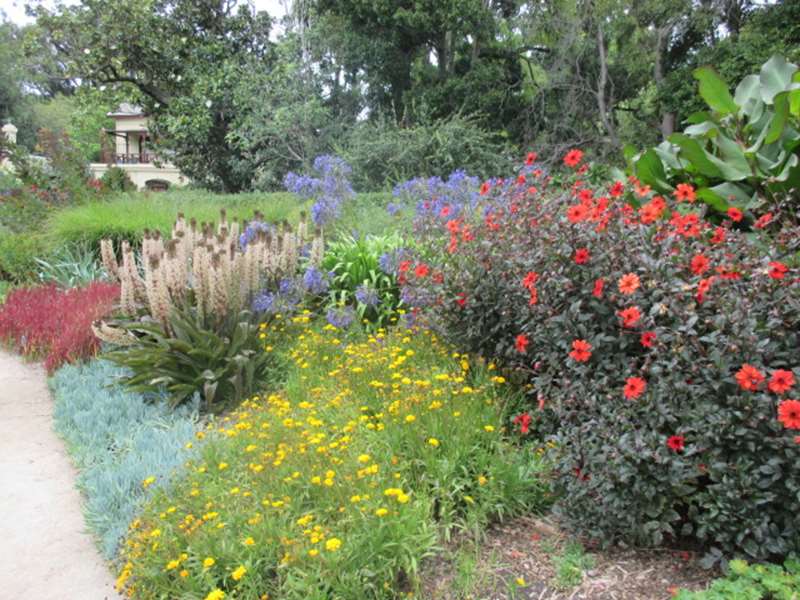
Founded in 1846, the Royal Botanic Gardens Melbourne is an inner-city oasis comprising 38 hectares of garden beds, lakes and sweeping lawns. It is home to 52,000 individual plants representing more than 10,000 species from around the world.
Attracting over 1.4 million visitors annually, the Royal Botanic Gardens Melbourne has stunning vistas, tranquil lakes and diverse plant collections.
The Royal Botanic Gardens Melbourne is home to both amazing and diverse plant collections such as camellias, rainforest flora, succulents and cacti, roses, Californian species, herbs, perennials, cycads and plants from Southern China.
The Gardens also provide a natural sanctuary for native wildlife such as the black swans, eels, bell birds, cockatoos and kookaburras.
The Gardens owes its botanic and heritage and landscape beauty to the first two Directors. Ferdinand von Mueller was one of the greatest 19th Century botanists, who introduced a vast array of plants to the Gardens and established the National Herbarium of Victoria. William Guilfoyle was an inspired landscape designer, who created the scenic panoramas that visitors enjoy today.
A popular attraction is The Ian Potter Foundation Children's Garden. The Children's Garden has everything that children could possibly want to help them discover the natural world: plant tunnels that they can crawl through, rocks that they can climb and a bamboo forest in which they can hide.
Garden Map:
You can use the interactive map to find your way around the gardens on a mobile device. There are also brochures with maps at the entry gates.
A map showing the layout of the gardens and highlights is:
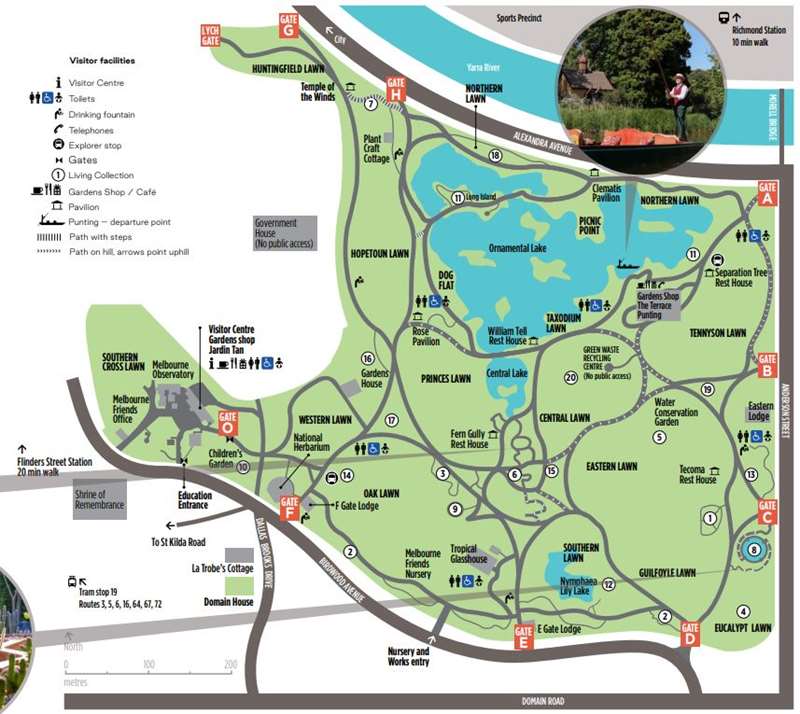
Garden Zones
1. Arid Garden
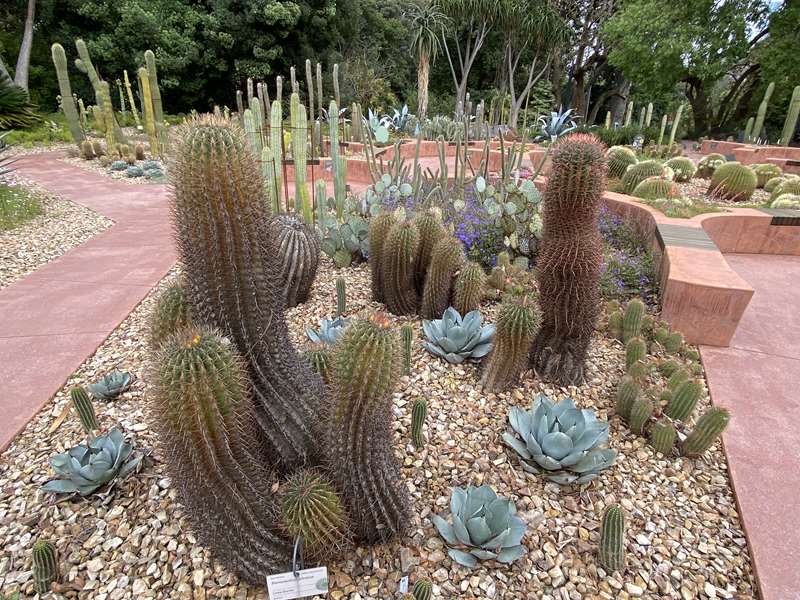
Wander the gentle curves of this masterfully designed garden. Here, you'll discover a variety of strong, safe and beautiful arid plants, perfectly displayed. Stand among the tall or focus on the small as you notice exquisite patterns, curious shapes, unexpected textures, and vibrant flowers.
Creative storytelling throughout the garden reveals nature's clever design. Many of the plants in this collection have been donated by the Field family - theirs is a beautiful story about childhood wonder and the power of collecting. Plan to stay awhile for there is much to discover.
Young botanists can search the story signs in the Arid Garden to find answers to these questions:
A. What two things make a cactus a cactus?
B. What two things do spines do?
C. Which pollinating animals am I attracting if my flower is white and I flower at night?
D. What is the name of the oldest cactus in the Arid Garden?
E. Which cactus will eventually become the tallest in this garden?
In Arizona, USA, it is illegal to steal, kill, shoot or deface their iconic Saguaro Cactus (Carnegiea gigantea). There are none in this garden they are difficult to source and very slow to grow.
One Opuntia species you WON'T find in this garden is Opuntia stricta, also called Prickly Pear. Native to the subtropical and tropical coast of the Americas, the British brought this prickly pear species to Australia in 1788 with the First Fleet. But it wasn't the plant that was of value; it was the cochineal bugs that lived on it. When crushed, cochineal bugs produce a crimson dye - the colour needed to dye the soldiers' red coats. With no natural predators, the prickly pear became a pest, ultimately invading vast tracts of land, a total area about the size of the UK. In 1925 a biological control was released - a moth, Cactoblastis cactorum (also native to South America). Within five years the moth larvae had nibbled the prickly problem away and this invasive species was all but eliminated. And that's why 'cactus' in Australian slang means beaten, broken, ruined, finished or kaput!
For some desert cacti, flowering is a dangerous business - a great deal of water is lost through petals. Their strategy: flower at night. Some flower rarely but profusely (even for just one night). And always with abundant pollen and nectar, and a powerful musty scent to attract pollinators (moths and bats).
The bloom of death! Many succulents are monocarpic (mono = single, karpos = fruit), which means after they flower, they die! But why the sacrifice? It's about limited resources. As soon as parent plants commence reproduction, they begin to die. They direct energy away from themselves (their roots and leaves) to the next generation (their flowers and seeds). Before they flower though, as an extra guarantee, they produce 'pups' - baby succulents around the base of the plant. Some succulents also produce 'plantlets' on their flower spikes - as the flower spikes fall to the ground, the plantlets grow
into a new plant. Most agaves, most aeoniums and all sempervivums are monocarpic. (The name sempervivum is Latin for 'always-living' - which they aren't, of course, but they certainly go out of their way to guarantee the survival of the next generation).
Do cacti die of old age? No - they've evolved to survive! But as their growth slows, they might crack, and if infection sets in, they may die. They can also die from overwatering. The species Echinopsis candicans is the oldest cactus in the Arid Garden, first planted around 1912 by Ralph Field. With tender loving care, these Echinopsis candicans may live for another 100 years.
A cactus may produce millions of seeds during its lifetime, but only one or two seeds will live long enough to produce a new cactus.
Did you know that the plural of cactus can be cacti, cactuses or even cactus! (Just like octopus, octopuses and octopi!)
The Blossfeld Expedition - From 1936-1938, a remarkable international cacti-collecting expedition took place in South America. Ralph Field invested financially and, for 200 pounds, was guaranteed delivery of at least a thousand varieties. The two-year expedition covered 6000 kilometres. Regular shipments of cacti were made to Ralph and by the time they arrived at the Melbourne Docks, some plants had been out of soil for up to five months.
2. Australian Forest Walk
Satisfy your senses with the reassuring and unique sights, sounds, and smells of Australia's eastern forests. Along the way, learn about the ingenious ways our trees have adapted to their environments, from ancient rainforests to deserts. Some of these forest giants were planted in the late 1800s, creating a shady canopy beneath which a diverse array of understory species thrives.
3. Camelia Collection
In winter, head to the Camellia Collection to find flowering in abundance. All camellias are native to Southeast Asia where they were first valued for their oil (extracted from seeds) or tea (from dried leaves). In Australia, we highly value them in our gardens for their spectacular show of wintertime flowers and year-round gorgeous glossy foliage.
4. Corymbia & Eucalyptus
On the Eucalyptus Lawn, hunt for trees planted by notable visitors.
5. Cycad Collection
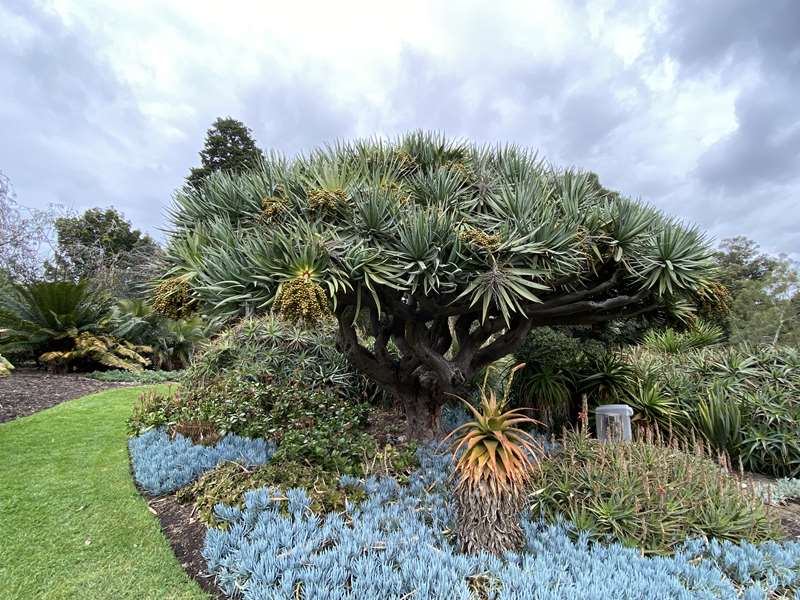
A little bit palm-like and a little bit fern-like, cycads have changed little since grazed upon by dinosaurs. Found from desert to rainforest, cycad occur in many countries throughout the world. Ancient heritage, slow-growers, long-livers, often with a specific pollinator - quite simply, a fascinating group of plants.
Their massive 'cones' and seeds are indicative of the now-extinct megafauna which grazed upon them, and the First Nations people of Australia and around the world have a long history of using them for food and crafting materials.
Cycads as a whole are one of the most critically endangered groups of plants in the world today.
6. Fern Gully
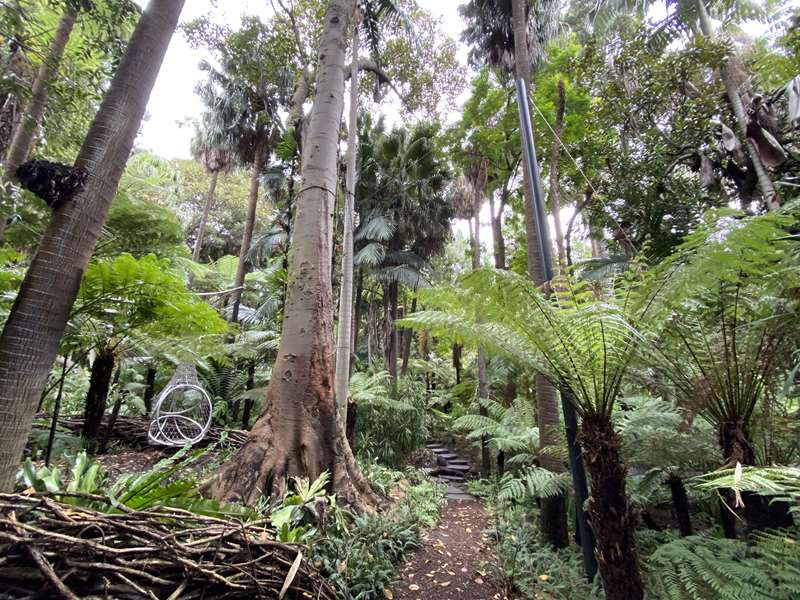
One of the most popular and tranquil places in Melbourne Gardens where lush ferns thrive beside a trickling stream, sheltered beneath a canopy of forest giants and stately palms.
A testament to the cooling power of plants, this glorious microclimate can be up to 6 degrees cooler than Melbourne's city centre. Although you'll find ferns from South-West Tasmania to Far North Queensland, and even New Zealand, more than half the ferns in Fern Gully are Victorian species.
This is a peaceful place of intricate patterns, filtered light and flitting birds. Head off the main boardwalk to find your own sanctuary in the secluded contemplation nooks.
7. Grey Garden
Grey plants are sometimes overlooked but grey and green complement each other beautifully.
In the Grey Garden Collection grey plants stand on their own with a surprising variety of textures and forms. Importantly, with such strategies as hairy, waxy, or succulent leaves, grey plants require little water making them perfect for an increasingly hot and dry climate.
8. Guilfoyle's Volcano
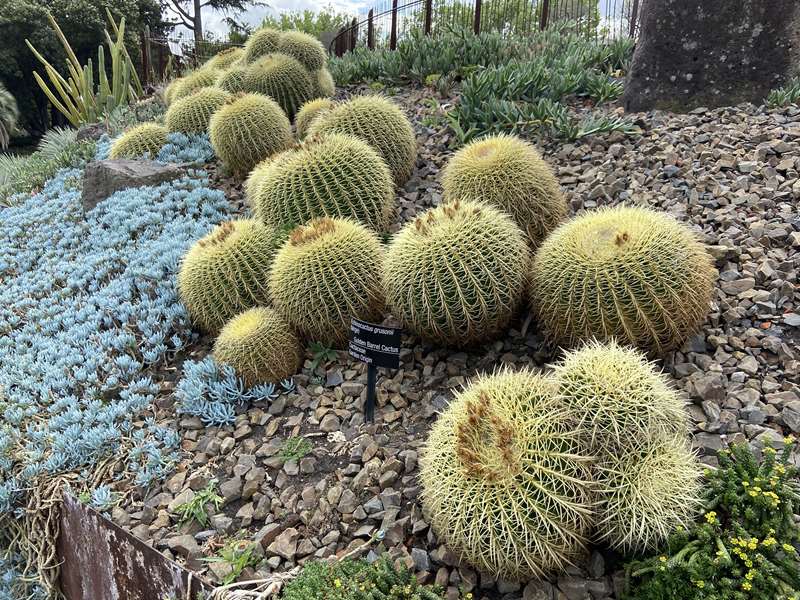
This is not really a volcano but, 50-million years ago there was a volcano near here, and most of Melbourne is built on the lava which flowed from it. You might have noticed the basalt volcanic rock in some of the garden beds. Inspired by this fun fact, in 1876, the Garden's second director Guilfoyle constructed a reservoir within a volcano-shaped hill at the garden's highest point to gravity feed water throughout the gardens. The 'volcano' is still used for water storage but is now part of a clever garden-wide water reticulation and treatment system.
On the sides of the 'volcano', the landscape architect has used red rock mulch combined with plantings of masses of succulents to mimic bubbling and flowing lava. Climb to the top and look down the sides of the 'volcano'. Does the way the plants have been arranged make it look like there is lava flowing from the 'volcano'? Other striking accent plants used are reminiscent of a desert landscape.
William Guilfoyle (1840-1912) was a great Australian landscape designer and Director of the Botanic Gardens 1873-1909. Born In England, the family emigrated to Australia in 1849. Like his father, Guilfoyle became a nurseryman and made many plant collecting tours to northern NSW and Queensland. In 1868 he joined a scientific expedition to the South Seas onboard H.M.S. Challenger, where he saw an active volcano. In 1876 Guilfoyle created a water reservoir in the shape of a volcano.
9. Herb and Medicinal Garden
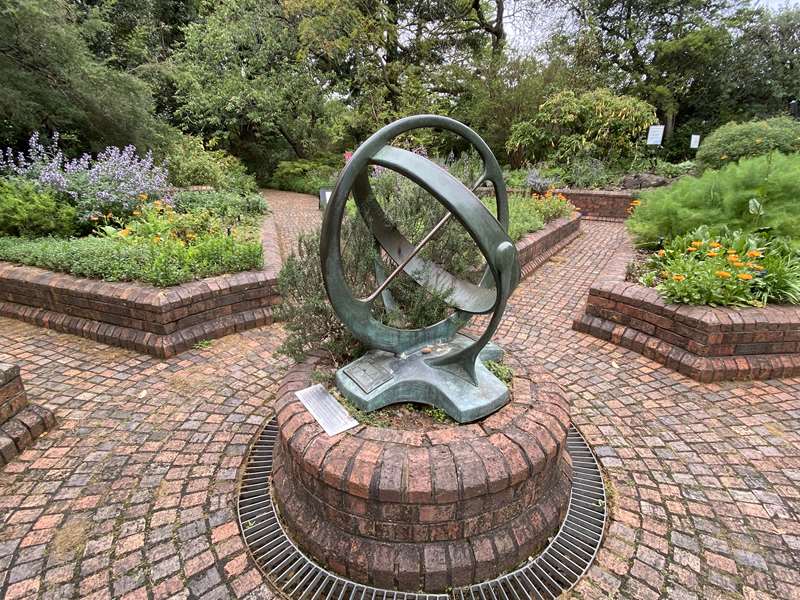
Delight your senses in this secluded garden - inhale deeply and touch gently. From tiny, short-lived annuals to grand, century-old trees, the Herb and Medicinal Collection includes a medley of plants from around the world. Their uses - medicinal, culinary, aromatic, and spiritual - are as diverse as their form and origin.
For peak fragrance, visit late spring to early autumn. Warning! Some plants in this collection are toxic or irritating. Please do not eat, and touch with caution if you are sensitive.
10. Ian Potter Foundation Children's Garden
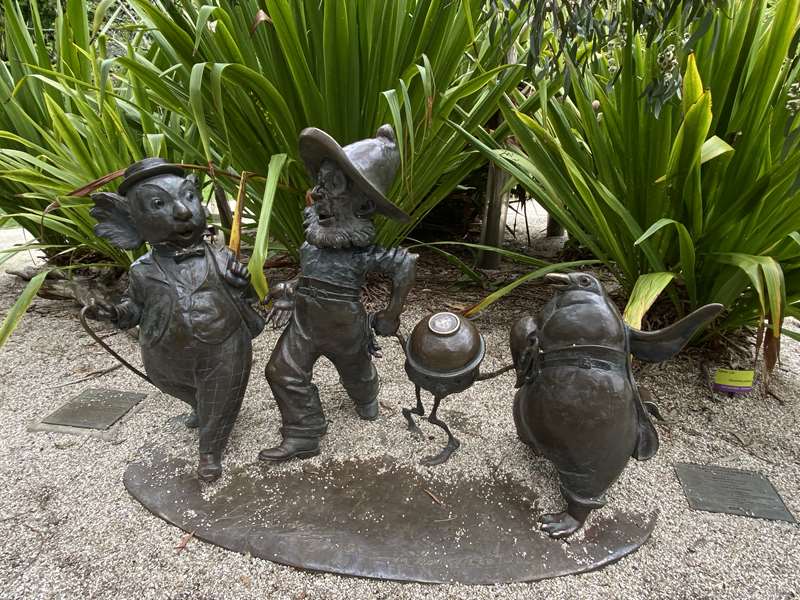
Visit this garden to jump, climb, crouch, crawl and wonder. With a bamboo forest, rocky gorge, running water and huggable trees, this is nature-based play at its best, especially designed to help children connect with the plant world.
The garden also includes a learning space, and a kitchen garden where children can see fresh fruit and vegetables growing.
11. Lower Yarra River Habitat
The area around the Ornamental Lake which can also be viewed on a punt.
12. New Zealand Collection
82% of New Zealand's flora is found nowhere else in the world, and there's a few unusual plant adaptations. But this collection faces big challenges. Melbourne's climate is significantly hotter and drier than New Zealand's, making this one of our most difficult plant collections to maintain.
13. North America Drylands
Meander the high rocky paths of the North American Drylands Collection to discover water-wise plants suitable for Melbourne. Significantly, a great majority hail from the California Floristic Province, one of the world's biodiversity hotspots, so declared for its species diversity and threatened status. Many species here hold great significance for North America's First Peoples.
14. Oak Collection
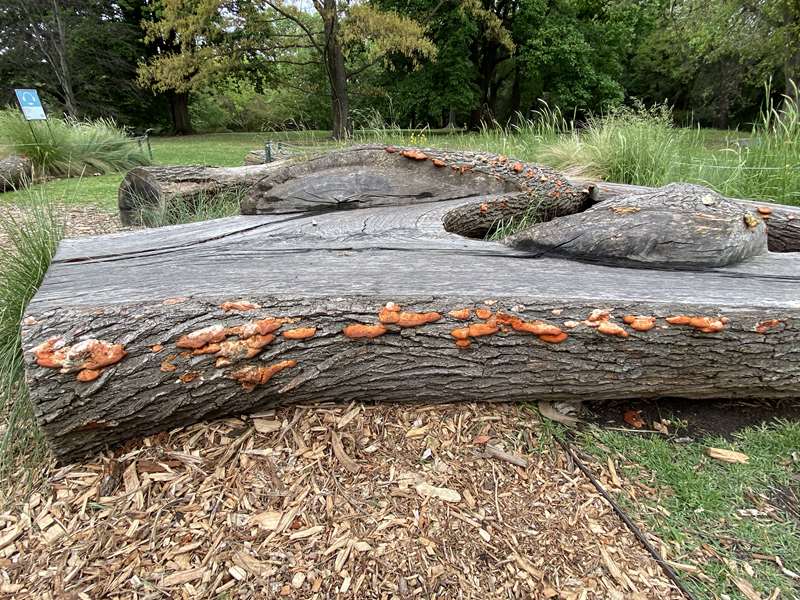
Oaks symbolise strength, endurance and wisdom and have been revered for centuries in their countries of origin. Visit Oak Lawn year-round to witness the changing seasons and cycle of life.
In Summer: rest beneath their leafy shade.
In Autumn: crunch through the falling leaves and see who can find the biggest Quercus robur (English oak) leaf.
In Winter: The oak trees provide shelter for many small animals in winter because their leaves often stay on even after they are dead, only falling off as spring approaches.
In Spring: see their bright green flower tassels (catkins) and fresh new leaves.
The Oak Lawn has a sculpture of acorns and a series of fallen trees with colourful orange fungi.
15. Palms
On Palm Lawn read a book under the canopy of the palm fronds.
16. Perennial Border
Enjoy the sumptuous display of colour, form and texture, as you wander along the half-moon path.
The design uses large and repeated drifts of plants to provide a lovely rhythm to the garden design, and a beautiful foreground for Gardens House behind. The display shifts in hue and focus from season to season.
17. Southern Africa Collection
Southern Africa is one of the world's biodiversity hotspots. In our collection, you'll find extraordinary species with wonderful form, texture and colour including bulbs, succulents, cycads, shrubs, and trees. And with a climate similar to Melbourne's, many have good horticultural potential for your own garden.
18. Southern China Collection
Slow your pace along the narrow serpentine paths (a feature of traditional Chinese garden design) to discover a little bit of China in the heart of Melbourne. The people of China take their plants seriously, value them highly, and name them creatively. Many of the plants in this collection are of great cultural significance - used for medicine, fibre, and festivals. Some will be familiar to you, while others are rare and threatened.
19. Species Rose Collection
As well as being a classic symbol of love and romance, roses are also highly valued for perfume, cooking, cosmetics, medicine, and religious practices. And they are possibly the most well-known and loved group of plants, with a rose collection included in most botanic gardens around the world.
Roses in this collection come from China, Europe, North America and the Middle East. Species have been selected which are suited to Melbourne's warming climate, which reduces the need for fungicides.
In a show of extravagance Roman Emperor Nero ordered rose petals costing nearly four million sesterces (around $500,000) to be rained down upon his guests at a feast. At this time roses were being imported from Egypt to support the unprecedented demand for these flowers.
A symbol of life - In the ancient Sufi religion of Persia the rose was symbolic of life's journey. Its beauty represented the perfection we should seek to achieve in life. The thorns were the challenges we face in trying to realise our goals. The fact that roses flower again signified that if we persist we will succeed in the end.
20. Victorian Rare & Threatened Species Collection
Here you'll find many of Australia's rare and threatened species, grown for botanical study and the preservation of their genetic material. By working closely with other botanic gardens and government departments we select priority species that are compromised by climate change and/or habitat loss, and give them a safe home.
Sensory Garden
Plants in this garden have been selected with you in mind. They've been chosen for their fragrance, colour, taste, texture and shape. Some are bold or subtle, zesty, spicy, papery, smooth, soft, prickly, rustly or crunchy.
Stay awhile, meditate using your senses one by one, and you'll see more, hear more, smell more, feel more. Created to nurture wellbeing, come here to rest and be enlightened.
Nymphaea Lily Lake
Look out for turtles and other wildlife.
Tropical Glasshouse
A hot house collection of cool plants.
Ornamental Lake
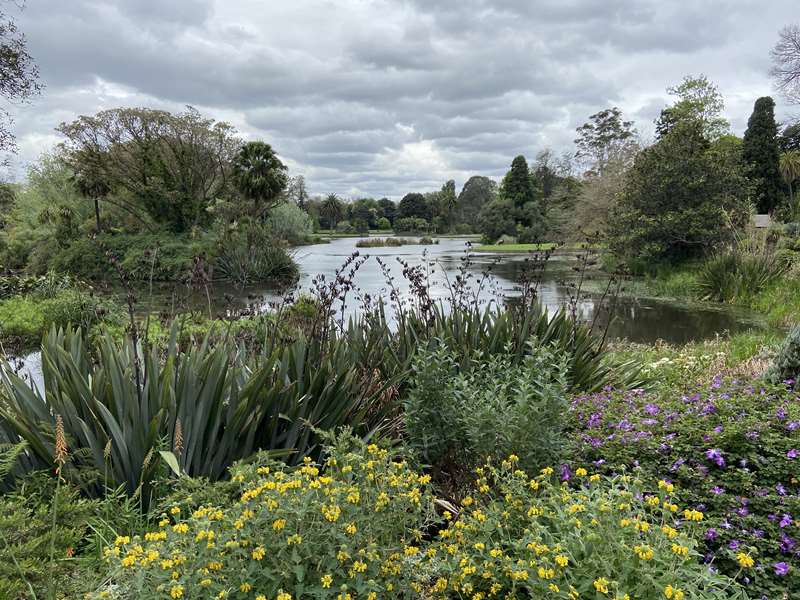
Reflect on what this landscape was like when this lake was part of the Yarra River, Birrarung.
Long Island
Spend some time here, imagining this place before colonisation. Traces of the original course of Yarra River, Birrarung can be seen - a precious remnant within today's heavily modified river. The original riparian habitat has been recovered through careful selection and planting of species that once grew here. Groups from the Kulin Nation, whose Country this is, contribute to this special collection through their storytelling and teaching about these plants and their traditional use.
Garden Facilities and Features:
Visitor Centre
Book a tour, ride the Explorer or chat to the helpful staff. The centre is open 9:30am - 5pm. There is a garden shop attached to the centre.
Jardin Tan
The eating area has a kiosk and cafe with a French-Vietnamese theme. Delight in delicious bites and drinks in a warm, welcoming space that celebrates farm-to-table philosophy and organic produce, some of which you will see growing in the eatery's very own garden. See the opening times for the kiosk and cafe.
The Terrace
The Terrace, which overlooks the Ornamental Lake has both takeaway and sit-down options, with a menu that features all the classics. See the opening times for the kiosk and cafe.
The Explorer
See sweeping landscapes, garden highlights and enjoy live commentary from a comfortable, open-air bus. Book a ticket on the Explorer.
Melbourne Observatory
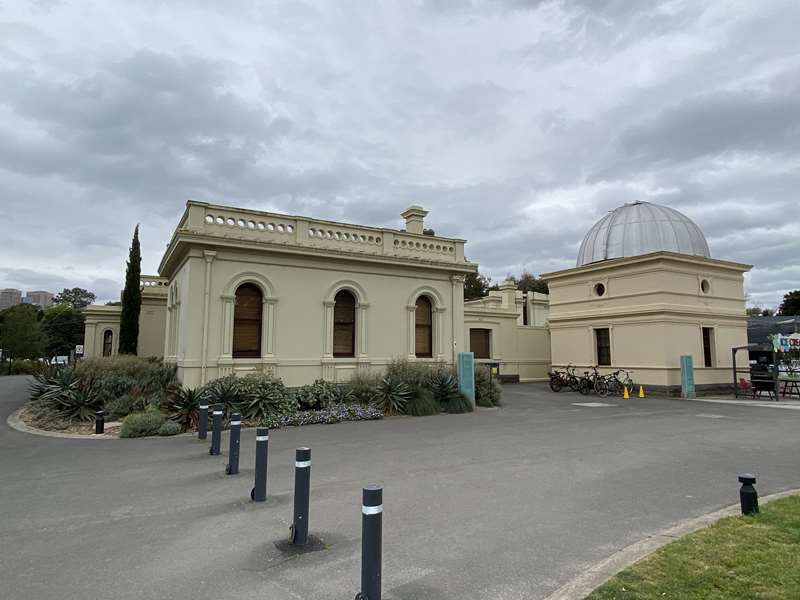
Heritage buildings which are home to star gazers since 1863.
National Herbarium of Victoria
The National Herbarium of Victoria was founded in 1853 by Government Botanist Baron Ferdinand von Mueller (1825-1896). It was the first herbarium established in Australia and is the oldest scientific institution in Victoria. Thanks to Mueller's tireless efforts, the collection is particularly rich in 19th-century specimens. These botanical time capsules give us insights into plant distributions, botanical history and past collecting methods.
The contemporary collecting focus is the flora and fungi of Victoria, but the Herbarium collection is global in scope. One of the great treasures of our global collection is the personal herbarium of Otto Wilhelm Sonder, which contains botanical specimens collected in six continents over five centuries.
The Herbarium is a dynamic working collection that continues to grow as new specimens are collected and preserved to support botanical and conservation research.
There is a Herbarium Discovery Walk with a number of information panels around the walls of the building. The inside of the building is not open to the general public but there is a plant identification service (fees apply).
Plant Craft Cottage
Discover the oldest building in the Gardens which displays arts and crafts.
Temple of the Winds
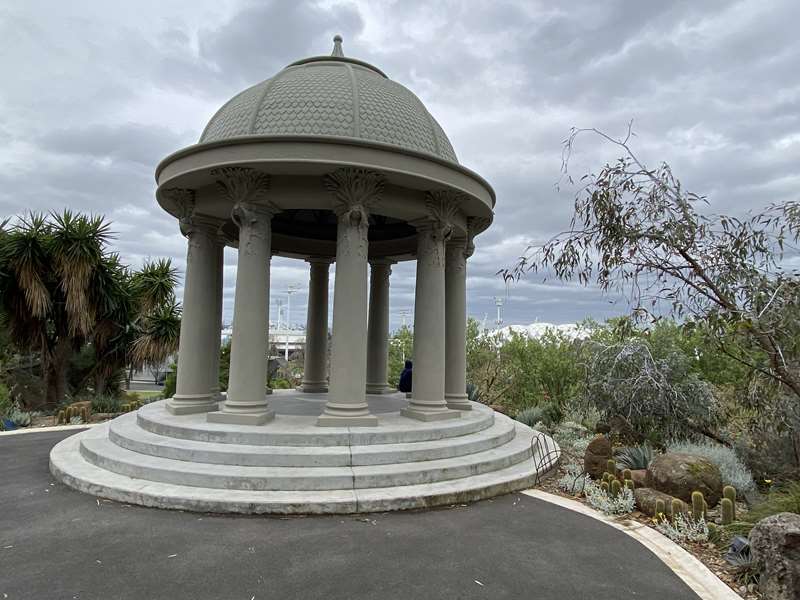
There are spectacular views across the river and city from the monument.
William Tell Rest House
Rest your legs in this unusual rest house by the lake.
Punting on the Lake
See the Gardens from a different angle on a punt. Book a punting cruise around the islands of Ornamental Lake in a timber punt. You will be guided through the Gardens' history and see the wildlife up close. Look for eels, spot birds and relax as you float on the picturesque water.
Aboriginal Heritage Walk
Journey into Royal Botanic Gardens Melbourne, a significant cultural site for the local Kulin Nation, with a First Peoples guide. Gain insight into the rich history and thriving culture of the First Peoples of Australia through a journey of identifying significant native plants within the Gardens. Learn about Aboriginal plant uses, customs and ongoing connection to Country. Book an Aboriginal Heritage Walk tour.
Forest Therapy at Melbourne Gardens
Originating from Japan, shinrin-yoku, or forest therapy, is a preventative health practice that immerses your senses in nature. This guided wellbeing experience will bolster your mental and physical health by reducing stress levels, regulating pulse and blood pressure and elevating your mood.
Recognised as a public health practice in Asia and Europe, forest therapy is gaining global acclaim as an evidence-based, cost-effective and natural remedy - a 'green prescription' for a healthier you. Surround yourself with biodiversity from across the globe at Melbourne Gardens. Book a Forest Therapy session.
Free Guided Walk
Discover seasonal garden highlights with an expert guide with a free guided walk.
Flora and the Baron
Flora and the Baron is a self-guided audio tour. Access via QR Code at Oak Lawn Gate (previously Gate F).
Sonica Botanica
Sonica Botanica is an immersive audio experience. Each episode responds to people, place and plants connected with specific collections or landscapes at Melbourne Gardens. Best experienced through your headphones whilst visiting the featured location.
Opening Hours:
Melbourne Gardens
Open every day of the year:
1 April - 30 September: 7.30am to 5.30pm
1 October - 31 March: 7.30am to 7.30pm
Visitor Centre
Daily 9.30am to 5pm. Closed 25 December and 1 January.
The Ian Potter Foundation Children's Garden
School Term: 10am-Garden Closing Time, Wednesday to Sunday.
Open every day during school holidays.
Closed from 11 July-3 September for winter rest.
Tropical Display in the Glasshouse
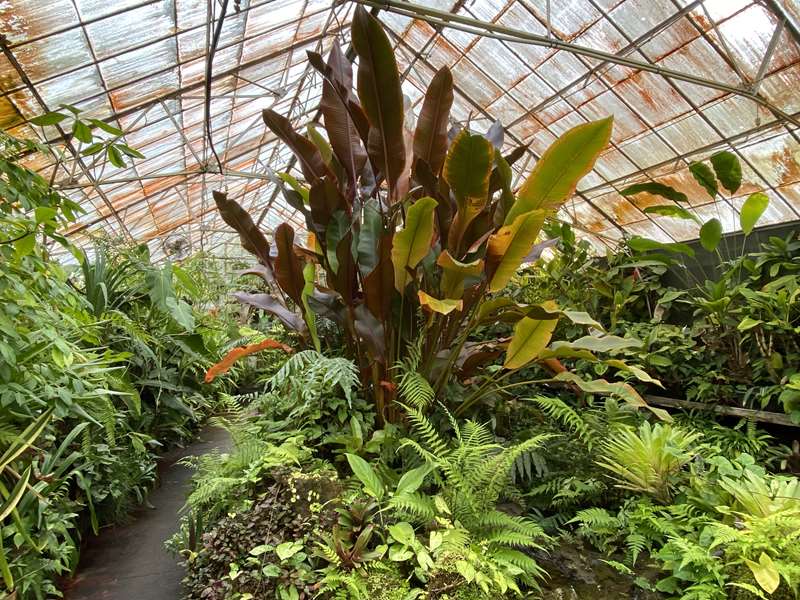
Open daily: 10am - 4pm.
Cost:
Free entry to the Gardens.
Access for Dogs:
Dogs are permitted in Melbourne Gardens provided they are kept on a short lead and supervised at all times to ensure the safety of delicate plants, other dogs and visitors.
Visitors with dogs must also ensure they pick up and remove from the Gardens any faeces deposited by the dog. Dogs are not permitted in The Ian Potter Foundation Children's Garden, Jardin Tan, The Terrace, Visitor Centre, shops or any other building unless they are required to assist a person with a disability. Dogs are only allowed during normal opening hours. Dogs are not allowed at ticketed programs and events, such as Lightscape.
There is also no cycling, e-scooters, ball sports or running permitted in the Gardens.
Review:
A trip to the Botanic Gardens should be on your to do list. There is a huge variety of landscapes and areas of interest. Top of the list for most kids would be the Ian Potter Foundation Children's Garden. The best zone for parents is the Arid Garden which is so interesting with lots of information about the cacti.
There are a few eating places in the Gardens. The Terrace overlooks the Ornamental Lake and has indoor and outdoor dining. Jardin Tan has a French-Indochina theme and has a cafe and kiosk. Prices are what you would expect - not horrific but not cheap either.
There are plenty of entrance gates, toilets, seats with lovely views, lawns for a picnic and water taps scattered about the Gardens. Try and find the swinging basket seat in the Fern Gully.
At the Visitor Centre you can pick up some "Seek and Find Nature Cards" for the kids. They are like a nature scavenger hunt with a range of things to find.
If the kids get a bit tired they can ride the Garden Explorer train and listen to the commentary about the Gardens. Tours start at the grand Oak Lawn. Tickets are available from the Visitor Centre, Lakeside Gardens Shop or the driver. The rides typically start at 10am and the last ride is at 3pm. The cost is about $15 for an adult and $35 for a family.
Another activity for the family is to take a punt ride on the Ornamental Lake. Tours leave from the Landing opposite the Terrace. Fees apply.
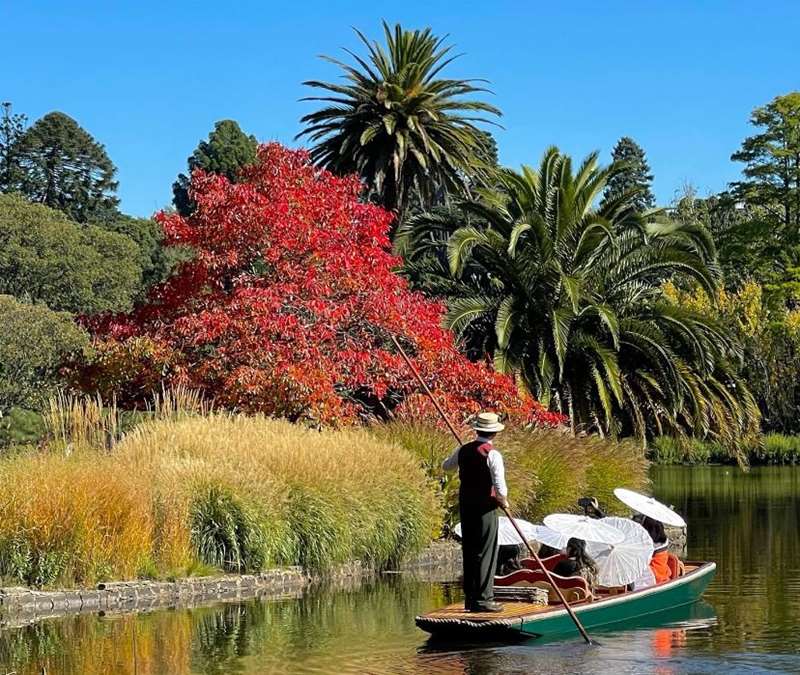
Photos:
Location
Birdwood Avenue, Melbourne 3000 Map
✆ (03) 9252 2300
Email Enquiry
Web Links
→ www.rbg.vic.gov.au
→ Royal Botanic Gardens Victoria on Facebook
→ Ian Potter Foundation Childrens Garden
→ Jardin Tan website
→ puntingonthelake.com.au
→ Punting on the Lake on Facebook
→ Royal Botanic Gardens Map
→ www.rbgfriendsmelbourne.org
→ Friends of the Royal Botanic Gardens Melbourne Inc. on Facebook
→ Royal Botanic Gardens Melbourne walk (Walking Maps)
→ Royal Botanic Gardens Melbourne Brochure with Map











